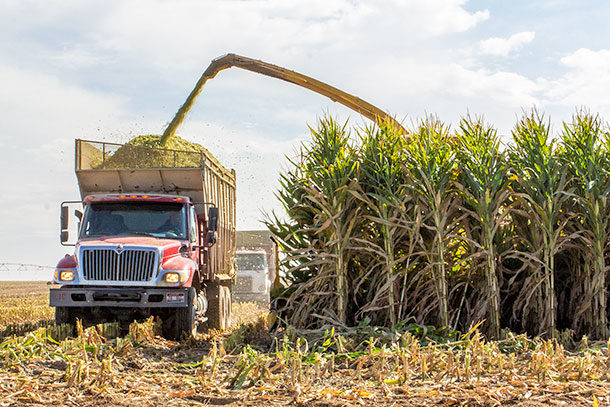When weather and growing conditions are less than ideal, it can be hard to know what steps to take to make the most of a subpar forage crop.
“When the good Lord blesses us with an extra 30% yield, maybe we should do something different with it, so we don’t waste this feed,” said Eric Dorr, silage specialist – North America, Chr. Hansen Animal Health & Nutrition.
Here are five silage strategies Dorr offered to a crowd of dairy producers at the Pacific Agriculture Show in British Columbia earlier this year.
1. Extract the air
“This whole process of making silage occurs with no oxygen,” he said. “We want this silage pile to go through this anaerobic fermentation, which means we extract the air out of it.”
Freshly harvested plants are still respiring. The faster you can eliminate oxygen to the plant cells by packing and covering the silage, the more nutrients will be preserved in the feed.
2. Density
“We have to do a better job of packing. I see a lot of low-density silage piles,” Dorr said.
Producers should follow the rule of 800. Take the tractor weight divided by 800 to find how many tons the machine is capable of packing per hour. Or, work the equation the other way. A common delivery rate is 100 tons per hour, which will require 80,000 pounds of pack weight.
The actual weight of tractors can be found by using the farm scale or through an online search.
“Even the big, big, big machines are really only capable of about 50 tons an hour,” he said, noting today’s chopping equipment can exceed this “very, very, very rapidly.”
Dorr stressed caution when adding weight or extra implements for packing, as the machine or operator may not be able to handle it safely.
Beyond packing weight, density can be managed with forage moisture level by harvesting in the ideal window, length of chop, push-up layer thickness and rate of delivery.
The person operating the pack tractor needs to “be empowered and have the ability to say, ‘Guys, we can’t bring it this fast because I can’t push it that fast,’” Dorr said.
If the driver doesn’t make that call, he or she ends up pushing too much feed, too fast with too thick of a layer. It doesn’t get packed, and the farm has poor-quality feed for the next 12 to 14 months.
3. Face management
Build the stored silage so the face can be fed in a day.
“Going higher to the sky is not the way to do it,” Dorr said. “Gravity is just a terrible way to unload a silo, so don’t build them to exceed your equipment-handling capacity.”
The ideal slope of a silage pile is 1-3. For every foot up, go three feet one way and three feet the other. However tall, make it six times wider. “On a drive-over pile, you should be able to go forward and backwards and up and over safely,” he said.
“Density is absolutely critical,” Dorr added. It not only helps minimize shrink, it also helps to get more feed in a smaller footprint.
4. Keep bacterial additives alive
Any investment in additives for better silage preservation can be lost if not managed correctly.
Use an insulated tank and consider adding frozen water bottles or ice packs to maintain the right temperature. If the solution is too hot, it can kill bacteria, which means they won’t be available to work on the silage.
Make sure tanks, hoses and applicators are clean or good bacteria will be contaminated with bad bugs. Also, check for kinks or worn parts that will affect the application rate.
“Check your own equipment if you’re doing your own harvesting, or, if you have a custom harvester, ask him to show you; you’re writing him the check,” Dorr said.
5. Kernel processing
Take about a liter of fresh feed and try to separate the kernels out of it, either dry or by dumping in water and letting the kernels float to the top, to make sure they are getting processed.
“Properly processed corn silage versus improperly processed is about five pounds of milk,” Dorr said.
Nobody wants to lose 20% of what they harvest, especially in areas where land is expensive. “If I just grew 100 acres of corn and I threw 20 of it away, maybe I’d be better off just taking one extra acre and doing something a little bit different so I can manage my silage better,” he said.











